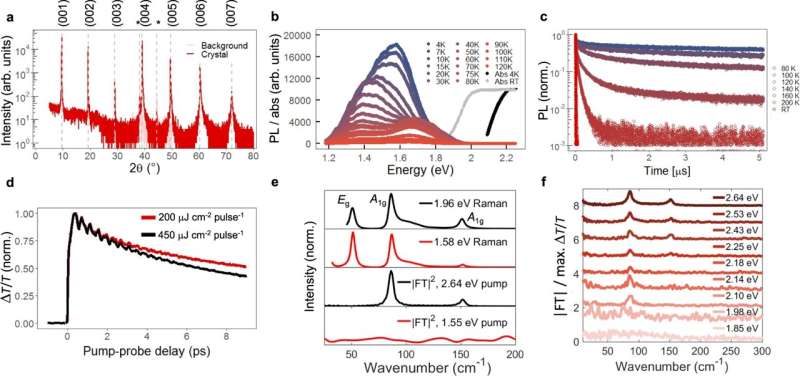This article has been reviewed according to Science X's editorial process and policies. Editors have highlighted the following attributes while ensuring the content's credibility:
fact-checked
peer-reviewed publication
trusted source
proofread
Sustainable solar cell material shown to be highly promising for medical imaging

A team of researchers, jointly led by the Universities of Oxford and Cambridge, have discovered that a solar cell material—bismuth oxyiodide (BiOI)—is capable of detecting X-ray dose rates over 250 times lower than the current best performing detectors used commercially. This has the potential to make medical imaging safer, and open up new opportunities in non-invasive diagnostics, such as X-ray video techniques. Their results are reported in the journal Nature Communications.
"We have developed BiOI single crystals into X-ray detectors that work over 100 times better than the current state-of-the-art for medical imaging," said Dr. Robert Hoye from the University of Oxford, who led the work. "BiOI is nontoxic, stable in air, and can be grown cost-effectively and at scale. We are very excited by the potential BiOI has to make the next generation of non-invasive diagnostics more accessible, safer, and more effective."
BiOI is a nontoxic semiconductor that absorbs visible light and is stable in air. Owing to these qualities, over the past decade there has been a surge of interest in this material for solar cells (turning sunlight into clean electricity), photoelectrochemical cells (turning sunlight into fuels) and energy harvesting to power smart devices, among many other applications.
BiOI contains two heavy elements—bismuth and iodine—which allows the material to strongly absorb X-rays. However, previous attempts to make BiOI into X-ray detectors were ineffective due to significant energy losses from defects arising from the nanocrystalline nature of the detectors made.
The researchers developed and patented a method to grow high-quality single crystals of BiOI using a scalable vapor-based approach. The low defect density in these crystals led to stable and ultra-low dark currents, which was critical to substantially improve the sensitivity and detection limit of this material to X-rays.
"Showing that these simply-processed, low-temperature grown, stable crystals can give such high sensitivity for X-ray detection is quite remarkable," said Professor Judith Driscoll from Cambridge's Department of Materials Science and Metallurgy, who co-led the work. "We began working on this material, BiOI, several years ago, and we find it outshines other rival materials in a range of optoelectronic and sensing applications, when toxicity and performance are considered together."
The researchers formed an interdisciplinary team to understand why BiOI works so well as an X-ray detector. They used advanced optical techniques to resolve processes taking place over a trillionth of a second, and coupled these with simulations to link these processes with what is happening at the atomic level.
Through this study, the team revealed the unusual way in which electrons couple to vibrations in the lattice. Unlike other bismuth-halide compounds, the electrons in BiOI remain delocalized, meaning that electrons can easily and rapidly move within the lattice of BiOI. At the same time, the unusual electron coupling with lattice vibrations results in an irreversible energy loss channel that would still be present even if the material were defect-free.
The researchers found that these losses can be overcome by cooling down the sample to reduce thermal energy, or by applying an electric field to rip away electrons from the lattice. The latter case is ideally matched with how X-ray detectors operate. By applying a small electric field, electrons can be transported over a millimeter length-scale, allowing the efficient extraction of electrons generated in the single crystals through the absorption of X-rays.
"We have built a microscopic quantum mechanical model of electrons and ions that can fully explain the remarkable optoelectronic properties of BiOI that make it such a good material for X-ray detection," said Dr. Bartomeu Monserrat from Cambridge's Department of Materials Science and Metallurgy, who co-led the project. "This gives us a roadmap for designing even more materials with similarly advantageous properties."
This work offers important insights into how delocalised charge-carriers can be achieved in bismuth-halide compounds. The researchers are now working on applying these insights to design materials with similarly advantageous properties as BiOI, as well as how to tune the composition of BiOI to improve its transport properties further. They are also working on bringing the unique benefits of BiOI to society by devising routes to increase the size of the BiOI detectors, while preserving the exceptional properties found in single crystals.
More information: Robert A. Jagt et al, Layered BiOI single crystals capable of detecting low dose rates of X-rays, Nature Communications (2023). DOI: 10.1038/s41467-023-38008-4
Journal information: Nature Communications
Provided by University of Cambridge





















